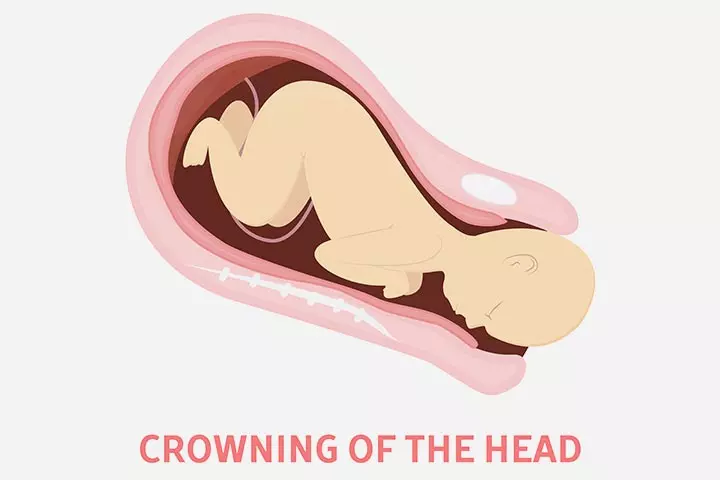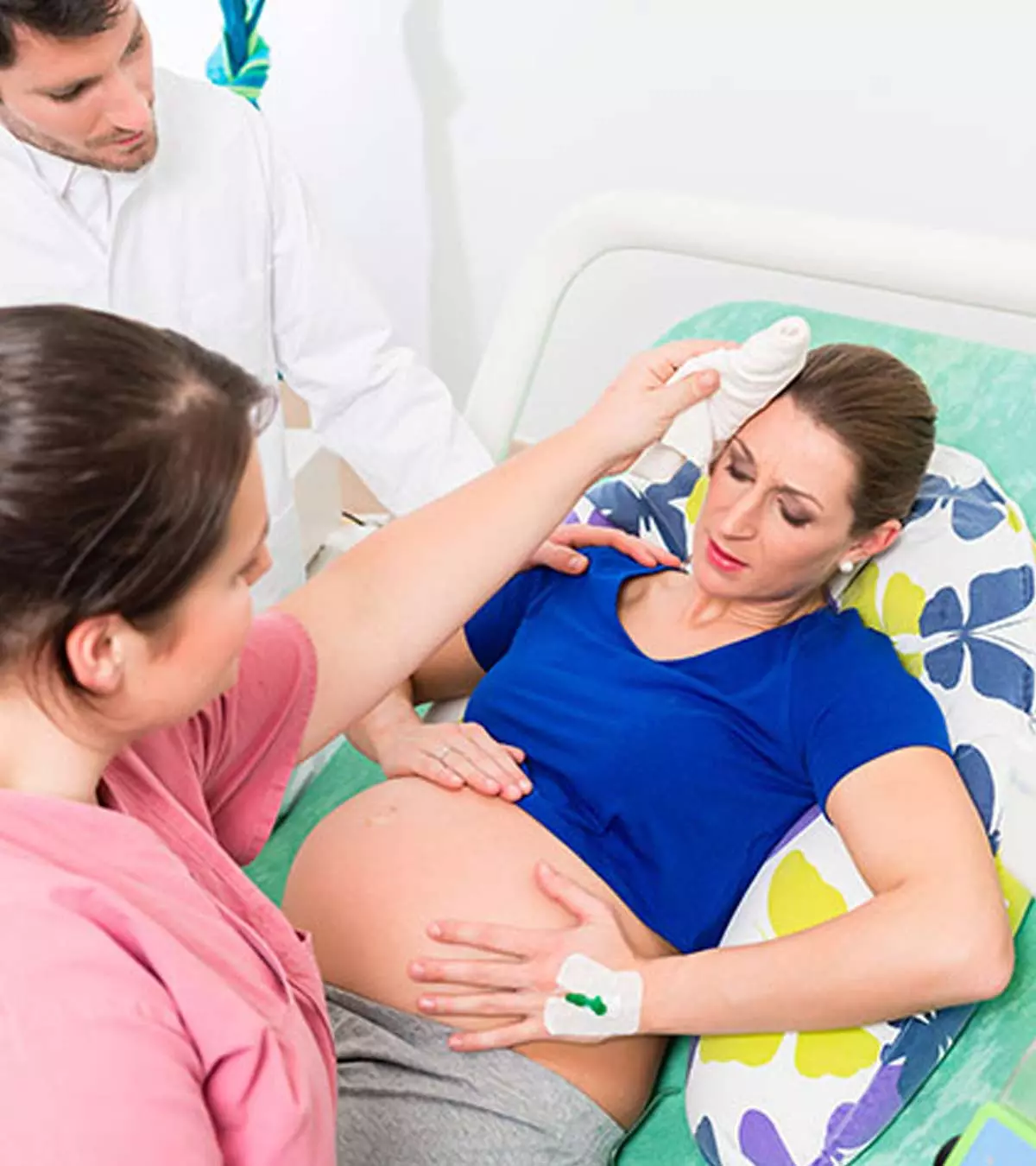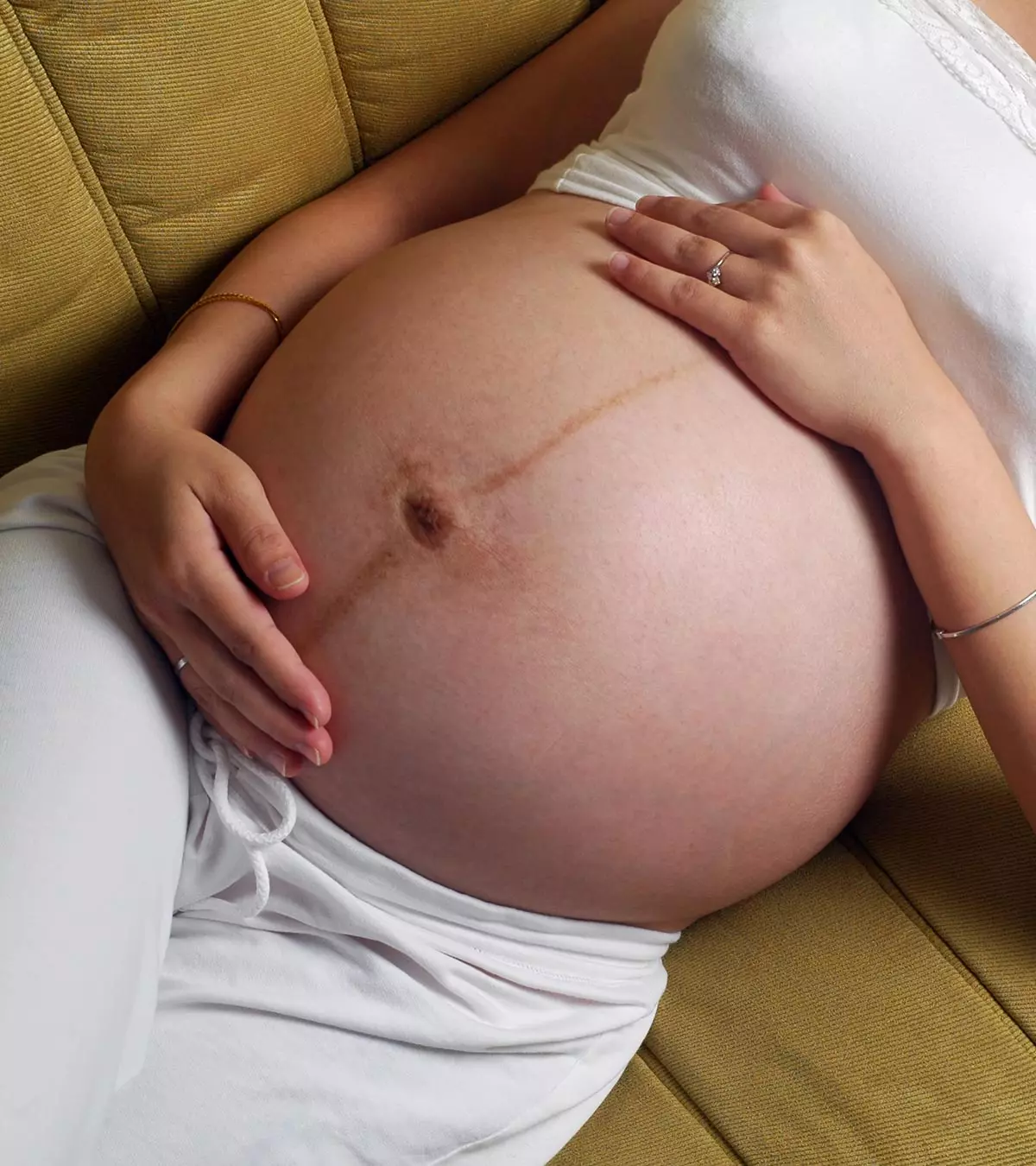
Image: ShutterStock
Baby crowning is when the baby’s head starts to appear during vaginal birth, and it is also known as vaginal crowning or birth crowning.

Weeks before going into labor, a woman’s body begins to prepare itself for the birthing process. Once the process of childbirth begins, it occurs in various stages, just like the stages of fetal development within the mother’s womb. Contractions are the initial step of childbirth, followed by pushing and baby crowning during delivery.
This post explains more about baby crowning, what it feels like, how to fight the urge to push, how to prepare for childbirth, and the duration of crowning.
Key Pointers
- Crowning occurs when the baby’s head appears at the mouth of the vagina.
- Tears during childbirth can be prevented by exercising regularly, having a balanced diet, using a side-lying position, controlled breathing, and using firm pushing techniques.
- During crowning, a burning sensation in the vagina is experienced, followed by numbness.
- Perineal stretching and massaging along with breathing exercises during pregnancy can assist in effective labor positions.
What Is Baby Crowning?

Active labor induces cervix dilation, after which, your baby’s head starts showing up through the vaginal opening with each contraction. A contraction develops when the uterine muscles tighten and relax to enable smooth fetal descent through the birth canal. As you start pushing, the baby’s head will appear, but once the contraction is over, it will withdraw from the view again.
The phenomenon of the baby’s head being visible without slipping back is known as crowning (1).
How Does It Feel When Your Baby Is Crowning?
When your baby starts crowning, you will feel a stinging or burning sensation, which is known as ‘the ring of fire’. It happens as the baby’s head stretches the vaginal opening.
The moment you experience the burning sensation, you should stop pushing. It helps lower the risk of vaginal tear or a need for an episiotomy. Once the burning sensation passes, it means that the primary stage of labor is over.
The stinging sensation or the ring of fire lasts for a short period before you experience numbness. The numbness occurs because the baby’s head stretches the vaginal tissue so thin that the nerves are blocked. It is like a natural anesthetic effect. One cannot predict for how long this stage will last (1).
Gretchen, a mom, shares her childbirth and labor experience. She says, “I continue to push with each contraction. Then I feel a sharp stinging sensation that feels like my skin is going to split up to my belly button. I keep saying, ‘it stings,’ and my midwife says, ‘That’s because the baby’s head is crowning.’ And then, everything slows down. My contractions slow down, and we just sort of hang out like that (i).”
 Did you know?
Did you know?Tips To Fight The Urge To Push
You should wait for your obstetrician or nurse to make you understand when you can fight that urge to push. The following tips can help you control the urge to push when the doctor or midwife asks you not to push (2).
- Lean back and try relaxing the pelvic floor muscles located in between your rectum and the vagina.

- Relax your complete body and your nurse or midwife may help you by offering a massage.
- Focus on deep breathing exercises that can help you relax. Your midwife will assist you with proper breathing patterns.
- Do not try to fight off the contractions. Allow them to work in your labor process.
Preparing For Childbirth
You can prepare for a natural childbirth crowning before the actual process begins. When you experience the burning, your midwife may offer a perineal massage to lower the risk of vaginal tearing and burning sensation (3). In some cases, you may have to go for episiotomy, a surgical incision of the perineum to facilitate the labor process.
The perineum is the skin between your rectum and the vagina. The area is massaged by inserting a lubricated finger to stretch the vagina for about 10 min every day. It is usually done from your 35th week of pregnancy (4).
Placing warm, soft cloth to the perineum and vaginal area also helps in preparing for the baby’s arrival. Additionally, practicing breathing techniques and strengthening the pelvic floor muscles may help expectant mothers feel more ready and confident for the experience.
How Can You Prevent Tears?
- Exercise regularly and have a balanced diet so that your tissues are healthy enough to withstand the pressure on them.

- Push the baby by lying on your side as this will lessen the pressure on the perineum.
- Take long breaths and push when you are exhaling. Instead of pushing violently, do the job slowly but firmly.
What Happens After Crowning?
During baby or labor crowning, your midwife will check for any obstructions and if the umbilical cord is wrapped around your baby’s neck. In some cases, they may have to use some means, like forceps or vacuum extraction, to deliver your baby manually.
After crowning, the entire head emerges followed by the body. The caregiver will suction your baby’s nose and mouth using a tiny bulb syringe to remove any excess fluids. The baby will be placed on your stomach, and the umbilical cord will be cut. All that is left inside your uterus is the placenta, the final stage of delivery.
Duration Of Crowning
If it is your first delivery, crowning may last for a couple of hours. If this is a second or subsequent delivery, it will be shorter.
 Quick fact
Quick factFrequently Asked Questions
1. What is the best position for baby crowning?
The best position may vary based on individual factors. Some naturally switch to all-fours or a wide-legged kneeling position. Alternatively, side-lying or semi-sitting are viable alternatives. It’s best to avoid lying on your back since it could make giving birth harder or squatting since it might increase the risk of tearing and require too much effort to maintain (7).
2. How long does baby crowning usually take?
The duration of crowning may vary based on experienced contractions, which may vary among women. Typically, after crowning, the baby is born entirely within a few contractions (7).
3. How can I help my partner during baby crowning?
Stay calm and focused, and be present both physically and emotionally. Listening to their needs, offering physical support, and following their lead can help make childbirth less stressful.
4. Is baby crowning a sign of imminent delivery?
Yes, crowning indicates that labor and delivery is imminent in most cases (8).
Understanding the stages of childbirth is helpful as it prepares you for the events in the maternity ward or delivery room and prompts you to practice effective pain management. Baby crowning is that stage of vaginal delivery (normal delivery) when you should be conscious about your pushes. As the baby’s head is trying to open the vagina at this stage, excess pushing could result in vaginal tears and extreme pain. If your baby is crowning, wait for your nurse or midwife’s signal to push. Seek their help in resisting the urge to push as they can check if there is any intervention in a baby’s safe delivery.
Infographic: How To Prevent Vaginal Tear And Stop Oneself From Pushing?
Vaginal tears during vaginal delivery can cause concern for many expectant mothers, especially during the first pregnancy. However, it can be prevented using some approaches. Read through the infographic below as we explain some ways to prevent vaginal tears and how to stop pushing to prevent vaginal tears.
Some thing wrong with infographic shortcode. please verify shortcode syntaxIllustration: What Is Baby Birth Crowning & How It Feels Like?

Image: Dall·E/MomJunction Design Team
Personal Experience: Source
MomJunction articles include first-hand experiences to provide you with better insights through real-life narratives. Here are the sources of personal accounts referenced in this article.
i. A birth story.https://clovescorner.blogspot.com/2011/12/birth-story.html
References
- Baby Crowning.
https://americanpregnancy.org/healthy-pregnancy/labor-and-birth/baby-crowning/ - Pushing: The Second Stage of Labor.
https://www.sutterhealth.org/health/pushing - Childbirth: Perineal Massage Before Labor.
https://www.uofmhealth.org/health-library/tn10339#:~:text=Starting%20at%20week%2034%20of,after%20a%20few%20massage%20sessions - Reducing your risk of perineal tears.
https://www.rcog.org.uk/for-the-public/perineal-tears-and-episiotomies-in-childbirth/reducing-your-risk-of-perineal-tears/ - What Happens During Crowning?
https://www.lamaze.org/Giving-Birth-with-Confidence/GBWC-Post/what-happens-during-crowning - Giving birth to your baby
https://www.nhsinform.scot/ready-steady-baby/labour-and-birth/giving-birth/giving-birth-to-your-baby - What Happens During Crowning?
https://www.lamaze.org/Giving-Birth-with-Confidence/GBWC-Post/what-happens-during-crowning - Childbirth And Obstetrical Emergencies
https://www.summahealth.org/-/media/project/summahealth/website/page-content/ems/ems-protocols/patient-care-protocols/childbirth-and-ob-gyn-emergencies.pdf?la=en
Community Experiences
Join the conversation and become a part of our nurturing community! Share your stories, experiences, and insights to connect with fellow parents.
Read full bio of Dr. Evert Pangkahila
Read full bio of Sakshi Mishra
Read full bio of Rebecca Malachi
Read full bio of Aneesha Amonz

















